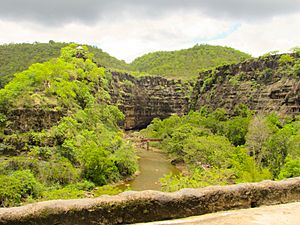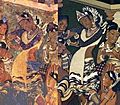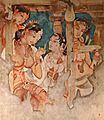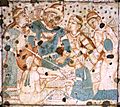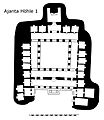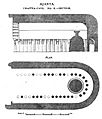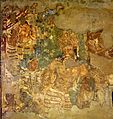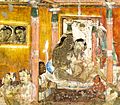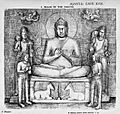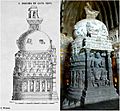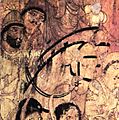Ajanta Caves are about 30 caves located in the Indian state of Maharashtra. With Ellora Caves, they are among the most-visted sites in India. The Ajanta Caves have been made an UNESCO World Heritage site in 1983. They are located in a valley, about 4 kilometres (2.5 mi) from the town of Ajanta, in the norwest of the state. Buddhist monks lived in the valley, from 2nd century BCE to about the 7th century CE. They used some of the caves to make temples. All the caves are located near a river, which only has water during and shortly after Monsoon season. Most of the caves were also used for living in them. Four are designed to be temples only. The most important caves also contain paintings.
The nearest train station is about 77 kilometres (48 mi) away, at Jalgaon. Most often, tours operate from the city of Aurangabad, which is about 100 kilometres (62 mi) to the south. The tours often include both cave systems.
Images for kids
-
Cave 19, Ajanta, a 5th-century chaitya hall.
-
Panoramic view of Ajanta Caves from the nearby hill
-
Cave 9, a first-period Hinayana-style chaitya worship hall with stupa but no idols
-
Name and date inscribed by John Smith after he found Cave 10 in 1819
-
Cave 24; the Ajanta Caves were carved into a massive rock on the Deccan plateau
-
Cave 4: a monastery, or vihara, with its square hall surrounded by monks' cells
-
Painted ceiling depicting Life circle of Lord Buddha
-
Buddhist monks praying in front of the Dagoba of Chaitya Cave 26
-
Ajanta Caves panorama with cave numbers. The caves are numbered from right to left, except for the later discovered cave 29, located high above Cave 21. Also, cave 30 is located between caves 15 and 16, nearer the river bed (cave invisible here). Chaitya halls are boxed (9, 10, 19, 26), and minor caves are indicated by a smaller type.
-
-
The frieze over the frontage of Cave 1 front shows elephants, horses, bulls, lions, apsaras and meditating monks.
-
Colonnades with high-reliefs in the veranda
-
Cave 4: The Buddha in a preaching pose flanked by bodhisattvas
-
Ajanta Cave 10 dedicatory inscription
-
The vihara brick monastery facing the caves at Ajanta. The cells were built around a stupa set on a central platform.
-
a detail: original left, copy by Lady Herringham (1915) right
-
Dancing girl in Ajanta fresco; a 2012 photograph (left) and Robert Gill's 19th-century copy
-
Copy of an Ajanta painting, in Musée Guimet, Paris. Part of a mural probably relating the conversion of Nanda, Cave 1.
-
Reproduction of The Adoration of the Buddha, cave 17, Albert Hall Museum, Jaipur, India
-
Upper part of the so-called "Persian Embassy Scene", with detail of the foreigners.
-
A foreigner in Sasanian dress drinking wine, on the ceiling of the central hall of Cave 1, likely a generic scene from an object imported from Central Asia (460–480 CE) The men depicted in these paintings may also have been Bactrians, at that time under Hephthalite rule.
-
Cave 17: many foreigners are included as devotees attending the Buddha's descent from Trayastrimsa Heaven
-
Cave 12 plan: an early type of vihara (1st century BCE) without internal shrine
-
Cave 1 plan, a monastery known for its paintings
-
Cave 6: a two-storey monastery with "Miracle of Sravasti" and "Temptation of Mara" painted
-
Cave 16: a monastery featuring two side aisles
-
Cave 10: a worship hall with Jataka tales-related art (1st century BCE)
-
Cave 9: a worship hall with early paintings and animal friezes (1st century CE)
-
Cave 19: known for its figures of the Buddha, Kubera and other arts (5th century CE)
-
Cave 19: another view (5th century CE)
-
Cave 2, showing the extensive paint loss of many areas. It was never finished by its artists, and shows Vidhura Jataka.
-
Cave 17 verandah doorway; eight Buddhas above eight couples
-
Section of the mural in Cave 17, the 'coming of Sinhala'. The prince (Prince Vijaya) is seen in both groups of elephants and riders.
-
Hamsa jâtaka, cave 17: the Buddha as the golden goose in his previous life
-
-
Sibi Jataka: the king undergoes the traditional rituals for renunciants. He receives a ceremonial bath.
-
-
-
Kinnara with kachchapa veena, part of Bodhisattva Padmapani painting in Cave 1.
-
Ajanta Cave 1 Group of foreigners on the ceiling
-
Cave 2 fresco above the right door shows Buddha in Tushita heaven
-
A scene from Vidurapandita Jataka: the birth of the Buddha
-
The artworks of Cave 2 are known for their feminine focus, such as these two females
-
-
The most intact painting in Cave 6: Buddha seated in dharma-chakra-mudra
-
Painting showing the Mahayana devotional worship to the Buddha
-
Buddha in the upper level, deer below and apsaras above (artificial lighting)
-
-
Cave 7 plan (Robert Gill sketch, 1850)
-
Cave 7: Buddhas on the antechamber left wall (James Burgess sketch, 1880)
-
Buddhas on the antechamber's right wall
-
The shallow corridor before the shrine
-
Buddha statue on the porch of Cave 9
-
The apsidal hall with plain hemispherical stupa at apse's center
-
-
Cave 9: fresco with Buddhas in orange robes and protected by chatra umbrellas
-
Cave 10, condition in 1839
-
The Buddha in long, heavy robe, a design derived from the art of Gandhara
-
Later painting with devotional figures, on pillars and ceiling
-
-
-
-
-
-
-
The conversion of sensuality-driven Nanda to Buddhism, left corridor
-
Palace scene fresco, right corridor of Cave 16
-
The Buddha in asceticism stage, getting sweet milk-rice from Sujata
-
Manushi Buddhas painting in Cave 16
-
Cave 16: king paying homage to the Buddha
-
Vessantara Jataka: the story of the generous king Vessantara
-
Shaddanta Jataka: six-tusked elephant giving away his tusks
-
Painting depicting "Darpana Sundari", a lady with a mirror
-
The Buddha in Cave 17 sanctum
-
Musician with Alapini Vina (far left), next to Indra.
-
Cave 19 plan suggests that it once had a courtyard and additional artwork
-
Nagaraja in ardhaparyanka asana, with his wife holding lotus and wearing mangalasutra
-
The nave has 15 pillars with Buddha reliefs
-
Buddha paintings in the side aisle of Cave 19
-
The Buddha on Lion throne
-
The sanctum has two Nagarajas on the side as guardians.
-
-
-
-
Sophisticated pillars of Cave 24 with embedded loving couples; evidence of parallel work
-
Cave 26 plan as completed. The etchings suggest the original plan was more ambitious.
-
The sculptured dagoba (stupa) in the worship hall. It has 36 carved panels.
-
Cave 26, left aisle wall: Mahaparinirvana of Buddha, or Dying Buddha
-
Buddhist vihara cell structure at the recently excavated brick monastery at Ajanta
-
Coin of Western Satrap Visvasena (293–304), found in the excavations at the monastery
-
-
-
Cave 2, ceiling: foreigners sharing a drink of wine
-
Cave 1, ceiling: another Persian-style foreign group, one of the four such groups (one now missing) at the center of each quadrant of the ceiling
-
A servant from Central Asia, Cave 17.
-
Cave 17: foreigners attending the Buddha
-
Cave 17: foreigners on horses attending the Buddha
-
Lady in blue dress with tiara, of possible "Persian origin"."
See also
 In Spanish: Ajantā para niños
In Spanish: Ajantā para niños
 In Spanish: Ajantā para niños
In Spanish: Ajantā para niños

